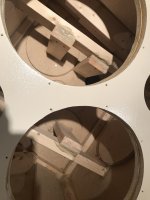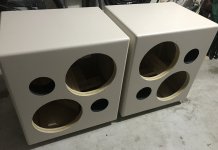Actually, 1/4" steel isn't all that stiff. Stiffness goes up with the cube of the thickness so a 3/4" plywood face would be about the same as 1/4" steel even though the modulus of steel is 210 GPa and plywood is about 8 GPa.It depends on a number of factors as to which method might be better. IF it's just stiffness you are looking for then bracing is the way to go.
However..
If you "wrap" the exterior of the cabinet with MDF (1/2" to 3/4") with viscous glue (something that doesn't stiffen-up much), then you will likely be better-off than bracing (..and this is coming from someone that hates MDF) overall - irrespective of stiffness. Most people wind-up using bracing that doesn't raise the panel modes enough and then don't damp the rest of the panel (usually internally).
The best thing you can do (mechanically) is use a baffle that is ultra-stiff: as-in 1/4" steel plate (that the driver is mounted to) - which radically improves clarity. (..Impedance compensation/flattening Impedance also does this electrically). I would rate both as a much higher priority than cladding/bracing. IF it's a ported design I'd also *damp the port and wax/polish the interior of the port. Fiber-fill is best used wrapped-around dowel bracing and kept OFF of the interior surface of the cabinet. (..waxing the interior cabinet surface is also a good idea).
*with port design I'll typically use a larger pvc/plumbing pipe that surrounds the exterior of the vent pipe but with a small amount of space between them - and fill that space with softer pure silicone caulk. Basically a "pipe within a pipe" where only the internal one vents to the exterior of the cabinet.
....
The best thing you can do (mechanically) is use a baffle that is ultra-stiff: as-in 1/4" steel plate (that the driver is mounted to) - which radically improves clarity. (..Impedance compensation/flattening Impedance also does this electrically). I would rate both as a much higher priority than cladding/bracing.
@ScottG would you please elaborate on your comment about impedance compensation improving clarity?
Are you saying that impedance compensation....alone...would improve clarity on a woofer running with no other passive components in its circuit?
Can you offer links to source info or conversation on this topic?
The tall one is an ML-TL to optimize for the available pipe), driver at one end, the terminus at thr otherInteresting... the El Pipo was not isobaric, it was opened at the top too...
The short one is a sealed isobarik PPPP.
dave
JBL 2035 HPL drivers sat in boxes, unused, for too long. And so I had to build something for them...
4508 enclosure was a logical solution, but for practical and aesthetic reasons I decided to build a 4745 lookalike (different volume and port size).
Totally happy with the result. And what I feared the most - boominess - is n o t there...
32"H x 29"W x 23"D
4508 enclosure was a logical solution, but for practical and aesthetic reasons I decided to build a 4745 lookalike (different volume and port size).
Totally happy with the result. And what I feared the most - boominess - is n o t there...
32"H x 29"W x 23"D
Attachments
I haven't tried to measure resonances of closed woofer "boxes"...
https://www.diyaudio.com/community/threads/aino-gradient-a-collaborative-speaker-project.231353/
https://www.diyaudio.com/community/threads/seas-mr18-3-way.322839/
https://www.diyaudio.com/community/threads/avalanche-as1-modernization.321711/
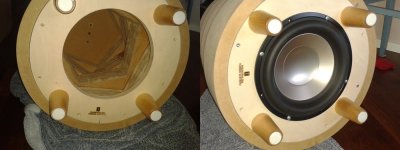
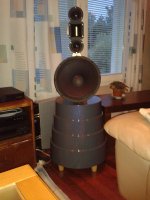
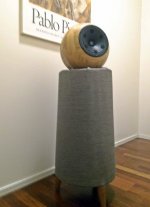
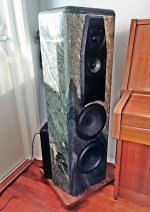
https://www.diyaudio.com/community/threads/aino-gradient-a-collaborative-speaker-project.231353/
https://www.diyaudio.com/community/threads/seas-mr18-3-way.322839/
https://www.diyaudio.com/community/threads/avalanche-as1-modernization.321711/




For those who feel that cylindrical enclosures don't offer any stiffness advantages, why do we not see cuboid high pressure gas bottles? To my mind, starting with a rectangular box and bracing it is akin to what Porsche did to 'cure' the late '60s 911 handling problems by putting 20kg of iron in the front bumper! It's a sticking plaster, not a cure. Us DIY-ers have the distinct advantage of not having to make a money from our creations, so we can start out with a better design strategy than profit-driven manufacturers with their quick and cheap square boxes. Tubes load the material in tension or compression (hoop stress), which in the case of plywood is at least three times higher than its bending strength, and the accepted 'compression ratio' maximum of 5% for a sealed enclosure would create a pressure of merely 1kPa.
If boxes are your thing, at least recess the baffle and rear panel to create I-beams around the enclosure which stiffen the flat panels significantly - it's a simple trick rarely seen these days. Hardwood battens in all joints perform a similar task and seem to be equally absent in many enclosures.
If boxes are your thing, at least recess the baffle and rear panel to create I-beams around the enclosure which stiffen the flat panels significantly - it's a simple trick rarely seen these days. Hardwood battens in all joints perform a similar task and seem to be equally absent in many enclosures.
The tall one is an ML-TL to optimize for the available pipe), driver at one end, the terminus at thr other
The short one is a sealed isobarik PPPP.
dave
So those 4th order crossovers... pretty steep, huh?
Pretty standard these days. Salen -Key Op-amp filters. Need some grounding tweaks, a snipped trace/wire (it is stereo but wired in mono) and a reg on the PS. The labels for the front also come as a separate sheet (why they were free)
dave
dave
Last edited:
Pretty standard these days. Salen -Key Op-amp filters. Need some grounding tweaks, a snipped trace/wire (it is stereo but wired in mono) and a reg on the PS. The labels for the front also come as a separate sheet (why they were free)
dave
I've been thinking of driving the subwoofers directly from an active crossover... I have this Sony EP9ES laying around that actually does a good job of bass management. It's for 5.1 ( 20 year old design ) but it does pretty good with music too.
Currently my Entec woofers have their own crossover plus a high pass output if I wish to use it for the mains.
I suppose that with an MT-TL like that, looks like a straight taper, you find a large amplitude resonance on the 3rd harmonic?
Regarding a stiff baffle: make it as small as possible and it will be stiff. 1.5 inch thickness is always a good idea. If you want to add baffle area to the front make those separate pieces though I cannot image there being much benefit in that below 100 Hz.
Actually, 1/4" steel isn't all that stiff. Stiffness goes up with the cube of the thickness so a 3/4" plywood face would be about the same as 1/4" steel even though the modulus of steel is 210 GPa and plywood is about 8 GPa.
When you cut a hole in the panel (like for a large 15" driver) is that true?
Also, what is the difference in hardness of the materials?
Last edited:
Subjectively I found this to be the case with a few different designs. (..this is irrespective to the typical LCR/RCL for getting your crossover to work properly.)@ScottG would you please elaborate on your comment about impedance compensation improving clarity?
Are you saying that impedance compensation....alone...would improve clarity on a woofer running with no other passive components in its circuit?
Can you offer links to source info or conversation on this topic?
For one thing it is dependent on the amplifier: typically there is a minimal impact with regard to a common voltage amplifier (say a bit higher than .1 ohm out) and the resulting damping factor. However I've found a much larger subjective difference than any change based on damping factor depending on the amplifier's power supply (some amplifiers with very high current power supplies really don't result in any subjective difference whereas most weak PS amplifiers (like with receivers) do result in a subjective difference).
Of course excursion matters as well - as you increase driver excursion the driver's in-box impedance "flatten's-out". This means that typically any subjective benefit is at lower spl. Further, the driver's Impedance "Q" also has an effect: the narrower the impedance "hump" the less the effect - as with low Qe drivers. Finally, I've found it has a greater effect with vented low freq. designs than sealed assuming that there isn't too much resistance (fiber) in the box.
No links on this subject that I'm aware of (other than the obvious differences in damping factor and excursion).
Yes. In my mind, this is the bigger factor.Anyone thought about panel excitation by the reactive forces in the driver chassis? To me these are far more problematic than the airborne sound transmission through the panels (yes, i know about mass law and coincidence effect, which are only partly of any use btw).
Airborne sound transmission can't be solved in a normal enclosure. Bracing or any other "normal" solution does nothing (below ~500Hz) because airborne sound will leak through the cone vastly more easily than through the a cabinet wall.
I experimented with this by taking measurements with a speaker inside a speaker. Even a stupidly stiff woofer (I loaded a normal woofer with a large ceramic plate + lots of mass) leaked sound orders of magnitude more than a box wall.
Similarly, I imagine that "balooning" from pressure changes will cause audible effects by deforming the woofer cone before it will observably deform a stiff enclosure.
Imagine a well built 100 litre box. There is a perfectly rigid piston on one wall of the box and a well built 15" woofer on the other. The voice coil of the woofer is fixed (glued to the magnet).
Now imagine what happens if you use the piston to reduce the enclosure volume to 90 litres, increasing the pressure inside the box. Which will balloon more - the box walls or the woofer cone?
airborne sound will leak through the cone vastly more easily than through the a cabinet wall.
While I understand the problem, I can say the IME with big boxes (440 liters and more) and big woofer cones, a well braced, well damped box makes a significant sonic difference. Like NO box talk, as in not sounding like a speaker at all. Not what we are used to hearing from bass boxes. Bracing and material has generally gotten much better over the decades, a lot of old boxes where thin and resonant, and it was clearly audible. Sound coming back out thru the speaker cone can't have changed much.
I don't deny that sound will come back out of the woofer, but box talk is a huge problem if not taken care of.
Yes. In my mind, this is the bigger factor.
Airborne sound transmission can't be solved in a normal enclosure. Bracing or any other "normal" solution does nothing (below ~500Hz) because airborne sound will leak through the cone vastly more easily than through the a cabinet wall.
You are clearly making the point for:
(1) A box less dipole woofer. Where the driver is mounted on a large surface with no box around it. There are quite a few designs...
(2) A huge box... Ideally, you should have a storage room behind the wall where you mount your woofers. Make sure the wall is triple layer with a sheet of acoustic sheetrock, over sheetrock over plywood. No openings from the storage room into the listening room, or if needed, put in a good outside quality door.
Either design ensures no significant pressure rarefaction or build up up behind the woofer. Sort of an isobaric configuration.
(3) Of course, an isobaric configuration with the second woofer going into a reasonable large box will attenuate the air pressure forces on the outside facing woofer.
Personally I like the idea of the storage room. What better place to store the LPs, assorted audio components, cigars, liquor, wine, toilet paper, etc... all the important stuff for a civilized life.
The more I think about it.. If you could build a fake wall at the end of your listening room, where the speakers go. With at least a 3 foot width so you can walk inside and do maintenance.. Then mount a whole bunch of 5 inch "woofers" into that wall. Something like 20 or 30. Drive them with a few Purify amps. In a stereo mode. Imagine, with 30 such drivers, it would be the same radiating surface as a stereo pair of 20 inch woofers but with outstanding dynamics and speed. Just put a couple of midrange midrange and tweeters on that wall... cover the whole thing with a tasteful cloth...
Last edited:
My understanding is that there are two main factors.Bracing and material has generally gotten much better over the decades, a lot of old boxes where thin and resonant, and it was clearly audible.
Factor 1) direct transmission, of vibrating woofer frame --> vibrating box.
That is, if you take a flimsy and resonant bass box, and carefully excise the woofer cone to leave just a bare voice coil + spider (a vibrating mass with minimal surface area), you'll still hear (loud) box resonances if you drive the voice coil. Some of these will be loud and also take a long time to diminish.
This is exactly how exciters / tactile transducers work.
Factor 2) airborne sound (the backwave of the woofer).
In a normal box, the backwave and frontwave are about equal, and all of the backwave has to go somewhere. Below about 500Hz, most of it comes bacl out through the cone.
Factor 1 is apparently a lot more important.
The observation of "no box talk" in good cabinets can only be due to improvements in direct transmission, because as you say, the other factor (airborne sound leaking back through the cone), hasn't changed much.
I've built + tried both types.You are clearly making the point for:
(1) A box less dipole woofer. Where the driver is mounted on a large surface with no box around it. There are quite a few designs...
(2) A huge box... Ideally, you should have a storage room behind the wall where you mount your woofers. Make sure the wall is triple layer with a sheet of acoustic sheetrock, over sheetrock over plywood. No openings from the storage room into the listening room, or if needed, put in a good outside quality door.
Either design ensures no significant pressure rarefaction or build up up behind the woofer. Sort of an isobaric configuration.
- quad 15" in a manifold built into a brick corner, in a brick and concrete (factory) space.
- single 12" in a 60Hz expo horn, 120*120cm mouth (tried with and without rear chamber).
IMO they both sounded good, but I think that's mostly because of their scale & very high efficiency, relative to the modest demands I put on them.
With the horn, I could measure the difference, between back chamber sealed/open, but subjectively there was no difference that stood out enough to notice, in an A/B test that took a couple of minutes to perform.
The factory system would have had very low "pressure rarefaction or build up up behind the woofer" - the enclosure being roughly 4 cubic metres - but the enclosure still vibrated a lot. That vibration must have been almost 100% due to woofer frame energy being transferred directly to the structure.
The floor of the factory enclosure was a concrete slab, the walls were big grey cinderblocks. The top was the weak link: a coupe of MDF sheets on pine framing, with a queen size futon on top of that. At loud-but-comfortable SPL, the bass would noticably vibrate the bed. I made the box top/bed base substantially more chonky (another layer of pine bracing, with concrete in the gaps, skinned with another layer of MDF) to damp it.
I'm very slowly (weekend hobby) building a structure to house a system that will be ~more of the same (IB array built into a wall).
Nice, so you built a vibrating futon bed... ;-)
Try this.
https://nts.com/services/testing/dynamics/vibration/
Eons ago, at work, we were setting up one of these babies and the door to the metrology storage room was locked so we couldn't get a signal generator.
So, I grabbed my Sony Walkman (yep!) with a cassette of the Rolling Stones... plugged and dialed it in, low pass filtered and started playing Sympathy For The Devil.
We found vibration nodes in our 2 story industrial building that no one had thought about. Our lab was in the ground floor and the R&D Dept above us emptied out within 30 seconds. It was described as The Big One (ie: "at least a 9 point zero!").
Try this.
https://nts.com/services/testing/dynamics/vibration/
Eons ago, at work, we were setting up one of these babies and the door to the metrology storage room was locked so we couldn't get a signal generator.
So, I grabbed my Sony Walkman (yep!) with a cassette of the Rolling Stones... plugged and dialed it in, low pass filtered and started playing Sympathy For The Devil.
We found vibration nodes in our 2 story industrial building that no one had thought about. Our lab was in the ground floor and the R&D Dept above us emptied out within 30 seconds. It was described as The Big One (ie: "at least a 9 point zero!").
Last edited by a moderator:
You are describing a Single Bass Array ideally having significant absorption on the opposite wall, and the baffle wall is going to have to be considerably more rigid than studs and plasterboard to not have resonances slap bang in the range we don't want them! My very first flat-to-20Hz sub excited the solid brick wall on which the turntable was mounted to such a degree that uncontrolled LF feed back occurred with the stylus resting on static vinyl. Five inch drivers are no more 'dynamic' or 'faster' in the LF range than large ones - unless you mean simply that they can play higher frequencies - and considerably less efficient. The bass wall idea is very appealing and has advantages on many fronts (pun intended), and is something I have always wanted to build, but sadly the ideal room I was going to use (partly underground and with 800mm stone walls) has now been taken over by a CNC router amongst other things... Both Single Bass and Double Bass Arrays are rarely implemented due to the dedicated space required, so first-hand information remains rare, however on paper it is technically superior.The more I think about it.. If you could build a fake wall at the end of your listening room, where the speakers go. With at least a 3 foot width so you can walk inside and do maintenance.. Then mount a whole bunch of 5 inch "woofers" into that wall. Something like 20 or 30. Drive them with a few Purify amps. In a stereo mode. Imagine, with 30 such drivers, it would be the same radiating surface as a stereo pair of 20 inch woofers but with outstanding dynamics and speed.
Wall of Bass
- Home
- Loudspeakers
- Multi-Way
- What’s stiffer, internal bracing or thicker sides???

